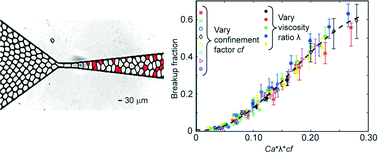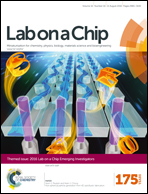Confinement and viscosity ratio effect on droplet break-up in a concentrated emulsion flowing through a narrow constriction†
Abstract
This paper describes the dimensionless groups that determine the break-up probability of droplets in a concentrated emulsion during its flow in a tapered microchannel consisting of a narrow constriction. Such channel geometry is commonly used in droplet microfluidics to investigate the content of droplets from a concentrated emulsion. In contrast to solid wells in multi-well plates, drops are metastable, and are prone to break-up which compromises the accuracy and the throughput of the assay. Unlike single drops, the break-up process in a concentrated emulsion is stochastic. Analysis of the behavior of a large number of drops (N > 5000) shows that the probability of break-up increases with applied flow rate, the size of the drops relative to the size of the constriction, and the viscosity ratio of the emulsion. This paper shows that the break-up probability collapses into a single curve when plotted as a function of the product of capillary number, viscosity ratio, and confinement factor defined as the un-deformed radius of the drop relative to the hydraulic radius of the constriction. Fundamentally, the results represent a critical step towards the understanding of the physics governing instability in concentrated emulsions. Practically, the results provide a direct guide for the rational design of microchannels and the choice of operation parameters to increase the throughput of the droplet interrogation step while preserving droplet integrity and assay accuracy.

- This article is part of the themed collection: 2016 Lab on a Chip Emerging Investigators

 Please wait while we load your content...
Please wait while we load your content...